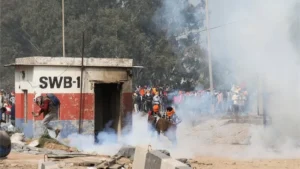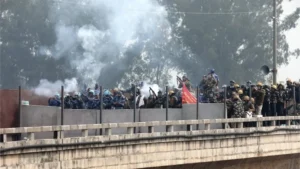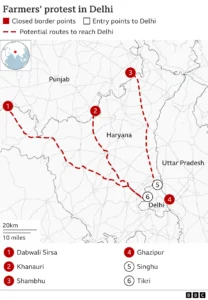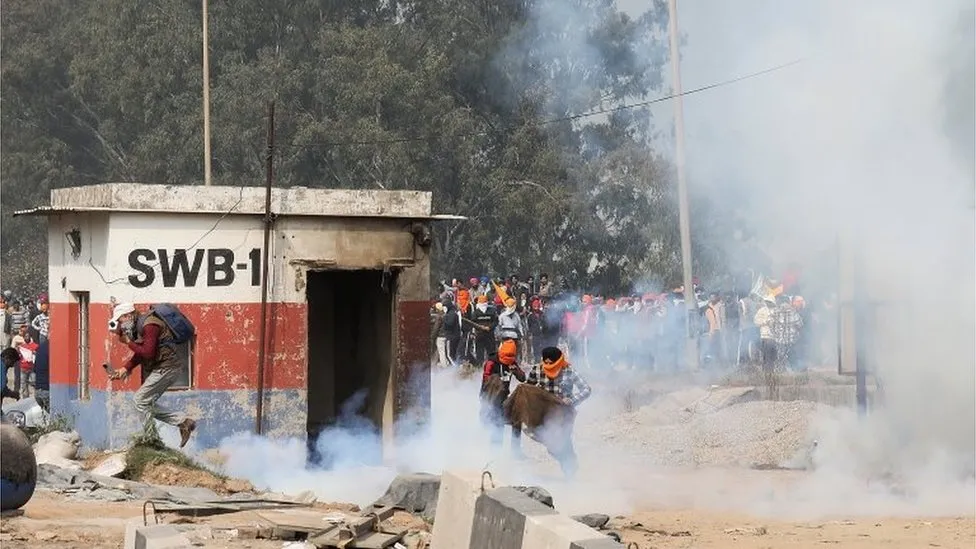Police in the northern region of India resorted to using tear gas in order to deter a large group of protesting farmers who were demanding minimum prices for their crops from advancing towards Delhi.
To maintain control and prevent protests, the capital is encircled by formidable barriers consisting of razor wire, cement blocks, and fencing on three sides.
The government is apprehensive about a recurrence of the events that unfolded in 2020, where numerous lives were lost during a year-long protest. The protest finally concluded when ministers consented to revoke contentious agriculture laws.
However, slightly more than two years have passed since then, and farmers assert that their additional grievances have yet to be addressed.

What is the reason behind the renewed protests by farmers in India?
India’s agricultural community holds significant political sway, and experts suggest that Prime Minister Narendra Modi’s government will be cautious not to alienate them. The Bharatiya Janata Party (BJP), led by Modi, is aiming for a third consecutive term in office in the upcoming general elections.
On Tuesday, distressing images emerged of dense clouds of tear gas being deployed to disperse demonstrators near Ambala, a city located approximately 200km (125 miles) north of the capital. Similarly, tear gas was utilized by the police at the Shambhu border between the states of Haryana and Punjab, as it had been the previous day. The scene was further intensified by the continuous presence of drones hovering above the crowd, releasing tear gas onto the individuals below.
The use of tear gas against protesters highlights the tense atmosphere surrounding the ongoing demonstrations. It also underscores the government’s determination to maintain control and order amidst the political climate leading up to the elections. The influence of India’s farmers as a voting bloc cannot be underestimated, and the government’s actions reflect a careful balancing act to avoid antagonizing this crucial demographic.
According to a BBC Punjabi reporter who witnessed the events, tear gas shells were continuously showered throughout the day. As a result, a small number of individuals in the crowd sustained injuries, primarily from being struck by plastic bullets discharged by the police.
In response to the situation, a group of protesters retaliated by hurling stones at the police. Meanwhile, the farmers took measures to shield themselves from the tear gas shells by utilizing damp sacks and clothing as protective barriers.
The farmers, predominantly from Punjab, express their desire to peacefully traverse Haryana in order to reach Delhi, yet they have been denied permission to do so. Incidents of clashes between the police and protesters have also been documented at the Shambhu border, contributing to the prevailing tense situation.
Last year, farmers engaged in a prolonged protest, obstructing the national highways that link the capital with its neighboring states. This movement was regarded as a significant test for Prime Minister Narendra Modi’s administration.
Families grieve the loss of farmers who lost their lives during the protests.
On Tuesday, there were widespread reports of traffic congestion and disturbances throughout Delhi as the authorities implemented road closures and redirected traffic. This resulted in significant delays and inconvenience for commuters and residents alike.
Additionally, the police have taken measures to prevent large gatherings within the city, particularly at the border points connecting Delhi with the neighboring states of Uttar Pradesh and Haryana. These precautions have been put in place in anticipation of the arrival of farmers who are expected to participate in protests in the capital.
In Haryana, the state government, led by the Bharatiya Janata Party (BJP), has taken the step of suspending internet services in seven districts until Tuesday. This decision aims to maintain law and order and prevent the spread of misinformation during this period of heightened tensions. Despite two rounds of discussions between farm union leaders and federal ministers, a resolution to the ongoing deadlock has yet to be reached.

Federal ministers convened a lengthy meeting with farm union leaders on Monday, spanning a duration of six hours. According to reports, both parties reached a mutual understanding on certain demands, which encompassed the withdrawal of legal cases filed against demonstrators during the protests that took place in 2020.
However, a unanimous agreement on the Minimum Support Price (MSP) could not be reached. Following the repeal of the farm laws in 2021, the government had announced the establishment of a committee tasked with exploring avenues to guarantee fair prices for all agricultural products. Nevertheless, the committee has not yet presented its findings and recommendations.
Over 200 farmer unions are taking part in the procession. Sarvan Singh Pandher, the general secretary of the Punjab Kisan Mazdoor Sangharsh Committee, stated to ANI news agency, “Our intention is to peacefully proceed and ensure that the government pays heed to our demands.”
Additionally, farmers’ and trade unions have declared a rural strike on 16 February, wherein all agricultural activities will be halted. In all villages, shops, markets, and offices will remain closed, while farmers will obstruct main roads nationwide.





Leave a Reply